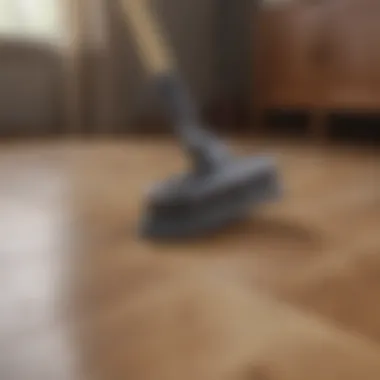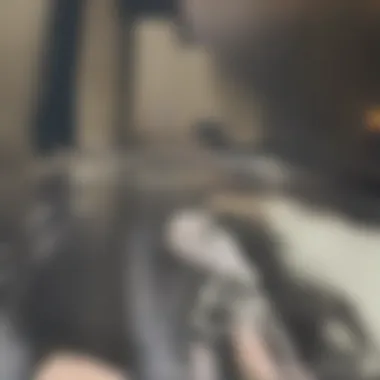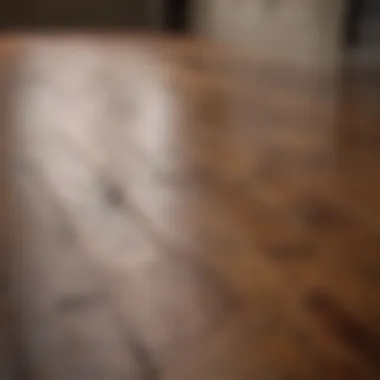Comprehensive Guide to Cleaning Hardwood Floors


Intro
Cleaning hardwood floors is a task that requires knowledge, precision, and the right tools. As one of the most attractive flooring options, hardwood floors add elegance to any home. However, maintaining their beauty and integrity involves more than just occasional sweeping. Understanding the appropriate methods and products is crucial for effective cleaning and maintenance. This guide will explore various techniques, tools, and preventive measures to not only clean your hardwood floors but also extend their lifespan.
Architectural Inspiration
Overview of Design Styles
Hardwood flooring can complement a variety of design styles, from rustic to modern. Each style influences the choice of wood type, finish, and maintenance approaches. For instance, wide-plank oak floors are often seen in farmhouse-style homes, while sleek, dark-stained hardwood suits contemporary spaces. Recognizing these styles allows homeowners to select the right flooring for their architectural preferences, ensuring harmony within the interior.
Innovative Materials and Techniques
In recent years, technology has brought forth new materials that mimic the appearance of hardwood. Companies have started producing luxury vinyl planks that resemble natural wood. These materials offer advantages in durability and ease of maintenance. Furthermore, understanding innovative cleaning techniques, such as the application of steam cleaning, provides additional options to keep floors looking pristine without risking damage.
Interior Design Trends
Color Schemes and Their Psychological Effects
Colors can significantly influence the perception of space. Dark wood floors often create a sense of warmth and coziness, while lighter shades may enhance brightness and openness in a room. This connection between color and psychology is essential when considering the aesthetic value of hardwood floors in interior design.
Space Optimization Tips
Using hardwood floors effectively can also enhance space optimization. Choosing the right grain direction, for example, can make a small room appear larger. Maintaining clean lines and uncluttered spaces around hardwood flooring helps maintain an airy feel.
"The right flooring choices can transform a space, adding depth, character, and value well beyond mere aesthetics."
Understanding Hardwood Floors
Hardwood floors are an elegant addition to any home. They enhance aesthetics while providing a sense of warmth and comfort. Understanding the different types of hardwood flooring and their characteristics is essential for homeowners looking to maintain their beauty and longevity. This knowledge helps in making informed decisions regarding cleaning and care methods, which ultimately contribute to the floor's durability and overall appeal.
Types of Hardwood Flooring
Solid Hardwood
Solid hardwood is made from a single piece of timber. This type of flooring is renowned for its robustness and natural beauty. One of the key characteristics of solid hardwood is its ability to be sanded and refinished multiple times. This longevity makes it a favorable choice for homeowners who wish to preserve their floors for many years.
Solid hardwood also tends to offer a unique grain pattern, which can enhance the aesthetic value of a room. However, it is susceptible to moisture damage. Therefore, it is crucial to maintain optimal humidity levels within the home.
Engineered Hardwood
Engineered hardwood consists of multiple layers of wood, typically with a veneer layer on top. This construction method makes it more resistant to changes in humidity and temperature compared to solid hardwood. The key characteristic that sets engineered hardwood apart is its versatility. It can be installed in various environments, including basements and areas prone to moisture.
The unique feature of engineered hardwood is that it maintains the appearance of solid hardwood while providing more stability. However, it may not be sanded as many times as solid hardwood, which can impact long-term maintenance.
Characteristics of Hardwood Floors
Durability
Durability is a critical aspect of hardwood floors. Solid and engineered hardwoods offer differing levels of durability based on their construction. Solid hardwood generally provides greater durability due to its thickness and solid structure. On the other hand, engineered hardwood offers adequate durability, especially in environments with higher humidity levels.
The ability to withstand wear and tear makes durable flooring an investment in long-term quality and aesthetic appeal. This range of durability options allows homeowners to choose the most suitable type for their specific needs and circumstances.
Maintenance Requirements
Maintenance requirements for hardwood floors can vary significantly depending on the type of flooring. Solid hardwood requires regular refinishing to maintain its beauty, while engineered hardwood often requires less extensive care.
A key characteristic of maintenance for hardwood flooring is the need for appropriate cleaning products. Using unsuitable cleaners can lead to damage. Therefore, understanding the maintenance needs of each type is essential for preserving the integrity of the floors.
When considering floor maintenance, always prioritize gentle cleaning methods over harsh chemicals to ensure longevity and maintain beauty.
Preparatory Steps for Cleaning


Before embarking on the cleaning of hardwood floors, it is essential to take a few preparatory steps. These steps ensure that you are adequately equipped and informed about the conditions of your flooring. Proper preparation can lead to more effective cleaning and can help prolong the life of the wood. By gathering the right supplies and assessing existing conditions, you create a tailored approach to maintenance that addresses specific needs.
Gathering Necessary Supplies
Cleaning Tools
Cleaning tools play a vital role in maintaining the beauty and integrity of hardwood floors. It is not just about having tools, but selecting the right ones that suit your flooring type. For instance, microfiber dust mops and soft-bristle brooms are popular choices because they effectively capture dust and dirt without scratching the surface. The key characteristic of these tools is their gentle nature, which makes them suitable for delicate finishes found in hardwood.
A unique feature of microfiber mops is their ability to trap debris while also holding moisture. This means less risk of excess water, which is crucial in preserving the wood's finish. However, it is important to keep in mind that using a vacuum cleaner specifically designed for hard floors can also prevent damage while offering a deep-cleaning effect. Your choice of tools should focus on avoiding any scratching or excess moisture that could lead to bigger issues in time.
Suitable Cleaners
The next step involves selecting suitable cleaners for hardwood floors. The right cleaning solution can greatly impact how well the floor is maintained. Cleaners specifically formulated for wood floors, like Bona Hardwood Floor Cleaner, contain ingredients that effectively remove dirt while being gentle enough for the wood finish.
A key characteristic of suitable cleaners is their pH balance. Many popular cleaners have a neutral pH, ensuring that they do not harm the wood or its finish. A unique aspect of these cleaners can be found in their ability to provide a protective layer, which can fend off minor scratches. However, it is essential to avoid cleaners with harsh chemicals or high pH levels, as these can strip the finish from the surface and lead to premature wear.
Assessing Existing Conditions
Scratches and Scuffs
Before you begin the cleaning process, it is necessary to assess the condition of your hardwood floors. Scratches and scuffs are typical signs of wear that can compromise the aesthetic appeal of your floors. Identifying these imperfections allows you to address them promptly. The benefit of assessing these damages early is that it can save time and effort during the cleaning phase.
One key characteristic of scratches and scuffs is that they come in various depths. Minor scratches may only require a simple cleaning or polishing, while deeper scuffs may necessitate a more detailed repair approach. Addressing these issues during initial assessments will ensure that your cleaning efforts yield more noticeable results.
Water Damage
Water damage is another critical factor to consider when preparing to clean hardwood floors. Excessive moisture can warp the wood, leading to irreversible damage. Identifying areas of potential water hazards is essential, especially in high humidity environments or near sources of water, such as kitchens or bathrooms. By recognizing these vulnerabilities, you can take immediate actions to rectify any sources of leaks or spills before undertaking the cleaning process.
The unique feature of water damage lies in its often-hidden nature. Early warning signs, such as discoloration or buckling, can indicate that the floor is already suffering. Taking meaningful preventative measures, such as investing in dehumidifiers or placing mats in high-risk areas, are beneficial practices to incorporate even before initiating your cleaning routine.
Proper preparation can significantly influence the outcome of cleaning hardwood floors, making the process smoother and more effective.
Methods for Cleaning Hardwood Floors
Cleaning hardwood floors requires careful consideration of the methods used. Choosing appropriate cleaning techniques maintains the integrity of the wood, prolongs its lifespan, and keeps it looking appealing. This section will explore various cleaning methods, focusing on dry and wet techniques that are essential to effective hardwood floor care.
Dry Cleaning Techniques
Dusting with Microfiber
Dusting with a microfiber cloth is a highly effective way to maintain hardwood floors. Microfiber has unique properties that allow it to trap and hold dirt and dust particles instead of just pushing them around. The key characteristic of microfiber cloths is their ability to attract dust due to their electrostatic charge, making them a popular choice for cleaning hardwood surfaces.
Using microfiber is beneficial because it minimizes scratching. Traditional dusters may leave residues or cause scratches on the surface. Therefore, incorporating microfiber dusting into your cleaning routine significantly protects hardwood floors from potential damage.
Benefits of dusting with microfiber:
- Versatile Use: Microfiber cloths can be used dry or damp, adapting to your cleaning needs.
- Eco-Friendly Option: They require less cleaning solution, reducing environmental impact.
However, an occasional drawback is that microfiber cloths need regular washing to remove the accumulated dirt, or they may lose their efficacy over time.
Using a Vacuum Cleaner
Using a vacuum cleaner specifically designed for hardwood floors is another crucial technique. These vacuums come with special attachments that safely clean wood surfaces without causing scratches. The primary advantage of using a vacuum is its efficiency in removing smaller debris and larger dust particles compared to manual methods.
Key characteristics of using a vacuum cleaner include:
- Time-Efficiency: Quick cleaning of large areas, making it ideal for routine maintenance.
- Deep Cleaning Capability: Vacuums can reach into crevices that dusters might miss.
A unique feature is the use of soft brush rollers, aiding in gentle cleaning. However, one must ensure the vacuum settings are appropriate to avoid any potential damage, especially with older wood floors.
Wet Cleaning Techniques


Using a Damp Mop
Using a damp mop can effectively clean hardwood floors without causing water damage. The principle of using a damp mop is to apply moisture without saturating the wood. This method is crucial to avoid warping or other moisture-related issues.
A damp mop is generally straightforward to use. When dampened correctly, it can remove stubborn dirt and grime while remaining safe for wood surfaces.
The most significant advantage of using a damp mop is that it can eliminate sticky residues left behind from everyday activities. However, it is essential to use it in moderation, as excess water can lead to moisture damage over time.
Applying a Wood Floor Cleaner
Applying a wood floor cleaner is a specialized approach in the cleaning process. Quality cleaners are formulated to maintain the finish of hardwood floors without damaging the surface. They often contain specific ingredients that break down dirt effectively while nourishing and preserving the wood finish.
One aspect to note about wood floor cleaners is that they are made to address different types of finishes. This ensures compatibility and effectiveness. The benefit of using dedicated wood cleaners is clear: they are often safer than generic cleaning products, thus helping to avoid unnecessary harm to the wood.
However, one must check the product's suitability for their specific hardwood type and finish, as using the wrong cleaner might lead to long-term issues such as discoloration or finish damage.
In summary, understanding the various methods for cleaning hardwood floors—both dry and wet—equips homeowners with the knowledge to maintain their floors effectively and ensure their longevity.
Preventive Maintenance Practices
Preventive maintenance practices play a crucial role in preserving the aesthetics and integrity of hardwood floors. By addressing potential issues before they escalate, homeowners can save time and costs associated with repairs. Effective preventive measures help maintain the original shine and beauty of hardwood floors, extending their lifespan. This section discusses two vital aspects: regular dusting and sweeping, as well as implementing area rugs.
Regular Dusting and Sweeping
Regular dusting and sweeping are fundamental in maintaining hardwood floors. Dust and dirt can cause micro-abrasions, which over time lead to noticeable scratches. Sweeping daily or several times a week is ideal, particularly in areas with high foot traffic. Using a soft-bristle broom or a microfiber dust mop is recommended to prevent damage while effectively collecting debris. In addition to keeping the surface clean, regular sweeping also helps in minimizing allergens and particulates in the air.
The frequency of dusting may vary based on several factors, including the number of household members and pets. For households with pets, a daily cleaning routine may be best. In contrast, for homes with minimal foot traffic, a weekly dusting may suffice. This proactive approach sets a solid foundation for further cleaning efforts and helps maintain the beauty of hardwood floors for the long term.
Implementing Area Rugs
Implementing area rugs is an effective strategy for enhancing preventive maintenance. They provide extra cushioning and protection against scratches, dents, and other forms of wear and tear.
Reducing Wear and Tear
Reducing wear and tear is essential for ensuring the longevity of hardwood flooring. Area rugs can effectively absorb impact, particularly in high-traffic areas. They add a layer of protection between heavy furniture and the flooring, preventing unsightly impressions or scratches. Another key characteristic of area rugs is their ability to trap dirt and moisture, which helps maintain a cleaner environment overall.
Choosing the right area rug adds to its effectiveness. For instance, a good-quality rug with a non-slip backing will provide stability and prevent accidental slips. However, it's important to inspect rugs regularly for any dirt that could transfer to the floor and cause damage. Implementing rugs may require an initial investment, but the protection they afford is an invaluable choice in hardwood floor care.
Choosing the Right Material
Choosing the right material for area rugs enhances their contribution to floor care practices. Natural fibers like wool are durable and effective at certain types of wear and tear. Synthetic fibers may also provide good options for different needs. Key considerations include durability, ease of cleaning, and the area’s overall aesthetic.
Certain materials, such as jute or sisal, lend a rustic ambiance but may not be suitable for areas prone to moisture. It’s important to think about the specific location of the rug to choose wisely. The wrong material could attract and retain moisture, which is damaging to wood floors. Ultimately, the right rug material is beneficial as it provides a barrier and enhances the room's overall look.
"Preventive maintenance not only preserves the beauty of hardwood floors but also enhances the resale value of your home."
Common Issues and Solutions
Addressing common issues is crucial for maintaining the beauty and functionality of hardwood floors. This section aims to highlight various challenges homeowners face and provide effective solutions. Understanding how to tackle these common problems ensures longevity and aesthetics of the flooring. Effectively managing issues not only enhances the visual appeal of the wood but also contributes to overall home value.
Minimizing Moisture Damage
Identifying Water Hazards
Identifying water hazards is vital for preventing further damage to hardwood flooring. Water is one of the most harmful elements to wood. Regularly inspecting areas prone to moisture, such as near sinks and entryways, can save floors from warping or mold. The key characteristic of recognizing these risks lies in understanding how moisture interacts with wood. It expands and contracts, leading to cracks and structural weakening over time. This practice is a beneficial choice, as it emphasizes the importance of prevention over repair.
Moreover, leaks can often go undetected until significant damage occurs. Identifying water hazards early can prevent costly repairs in the future. Being proactive is a unique feature of this approach, allowing homeowners to address problems before they escalate.
Immediate Actions to Take
When moisture issues are detected, immediate actions can minimize the extent of the damage. First, prompt drying is essential. Using towels and fans can help eliminate excess water quickly. The key characteristic of timely responses is their ability to prevent permanent damage. It is a beneficial way of preserving the integrity of hardwood floors.


Another unique feature of taking these immediate actions is the realization of how fast damage can escalate. Simple steps like moving rugs and furniture off damp areas further protect the wood. As a disadvantage, one might find that these actions may require time and consistency, yet the benefits far outweigh the drawbacks.
Repairing Scratches and Dents
Using Wood Fillers
Using wood fillers is an effective method for repairing scratches and dents on hardwood floors. This solution allows homeowners to restore the integrity of the flooring without requiring full refinishing. The key characteristic of this method is its ease of use. Many fillers are available in various shades, making it a beneficial choice for homeowners. They can match the color of the wood, ensuring that repairs blend seamlessly.
A unique feature of wood fillers is that they often come ready to use, which adds convenience. Nonetheless, a notable disadvantage is that some fillers might not adhere perfectly over time. Regular maintenance is necessary to ensure longevity.
Refinishing Techniques
Refinishing techniques represent a more extensive approach to restoring hardwood floors. This can dramatically alter the appearance and integrity of worn or damaged floors. The key characteristic of refinishing is that it can remove deep scratches and surface blemishes. It offers a fresh surface, making it a popular choice. Homeowners might find this process beneficial, especially in older homes where wear is more pronounced.
However, the unique feature of refinishing is that it can require considerable time and effort. It is a labor-intensive process that may necessitate hiring professionals if one lacks experience. The disadvantage is clear: it could be disruptive and costly. Yet, its advantages make it relevant for homeowners looking to enhance their flooring's aesthetics and durability.
"Regular maintenance and prompt attention to common issues prolong the life and beauty of hardwood floors. No homeowner should overlook the importance of proactive care."
By understanding these common issues and their respective solutions, homeowners can enhance their hardwood floor's longevity and visual appeal. Proactive measures in identifying moisture hazards and using effective repair methods are essential practices to ensure flooring remains in good condition.
Environmental Considerations in Cleaning
Cleaning hardwood floors is not just about restoring their shine and beauty; it is also about doing so in an environmentally responsible manner. With increasing awareness about environmental issues, it becomes crucial to consider how our cleaning practices impact both the wood and the environment. The choices made in cleaning products and methods can lead to significant benefits, not only for the floors themselves but also for the ecosystem.
Eco-Friendly Cleaning Products
Using eco-friendly cleaning products is essential. These products are formulated without harmful chemicals, making them safer for both your family and the environment. When selecting cleaners, look for options that are biodegradable and free from harsh solvents.
Some recommended eco-friendly options include:
- Vinegar and Water: A simple mixture can effectively clean hardwood floors while leaving no toxic residue.
- Castile Soap: This biodegradable soap works well in removing grime without harming your floor finish.
- Commercial Eco-Friendly Cleaners: Brands like Bona and Method offer specially designed products for hardwood that contain plant-based ingredients.
By choosing eco-friendly products, you reduce the release of volatile organic compounds (VOCs) into your home. This supports better air quality, which is especially vital for those with sensitivities or allergies.
Sustainable Floor Care Practices
Sustainable floor care practices ensure that your cleaning habits do not adversely affect the longevity of your hardwood floors or the environment. Implementing these practices can significantly reduce waste and promote a healthier indoor atmosphere.
- Regular Maintenance: Routine cleaning helps maintain the floor's finish and reduces the need for more aggressive cleaning methods that may involve harsher chemicals.
- Avoiding Excess Water: Water can warp hardwood floors. Using a damp mop instead of soaking your floors is a good practice.
- Recycling Old Cleaning Materials: Instead of disposing of old microfiber cloths, consider repurposing them or finding suitable recycling programs.
- Educating Yourself on Products: Read labels and product reviews. Understanding what products work best without damaging the environment aids in sustainable choices.
"Sustainability in cleaning is not just a trend; it is a necessity for the health of our homes and our planet."
By adopting these sustainable practices, you contribute to reducing environmental impact while preserving the life and beauty of your hardwood floor. Ultimately, it is about making informed choices for the well-being of your home and the larger community.
Professional Cleaning Services
The decision to hire professional cleaning services for hardwood floors can be significant for homeowners seeking optimal care for their flooring investments. Hiring experts can ensure deeper cleaning and maintenance that may not be achievable through regular household methods. The specialized knowledge and equipment used by professionals can tackle tough stains, restore shine, and address damage effectively. Moreover, homeowners can benefit from tailored solutions in maintaining their specific type of hardwood flooring.
When to Consider Hiring Professionals
Assessing Severity of Damage
Assessing the severity of damage to hardwood floors is crucial. This involves identifying issues such as deep scratches, worn surfaces, or water damage. A professional can offer an objective view of the situation, which is essential. Experts often use advanced techniques that can rectify or minimize damage better than consumer-grade solutions. Moreover, this assessment helps in determining whether a simple cleaning is adequate or if refinishing or repairs are necessary. Such a discerning approach can lead to longer-lasting results.
Time Constraints
Time constraints often play a significant role in the decision to hire professionals. Many homeowners lead busy lives, and finding the time for thorough cleaning can be challenging. Professional services can provide the needed deep cleaning in a fraction of the time it would take an average person. This means homeowners can focus on other important tasks and rely on experts to restore the beauty of their hardwood floors. However, this comes at a cost, as professional cleaning fees can be higher than DIY methods.
Finding Reliable Cleaning Services
Researching Local Options
Researching local options is an essential step in finding trustworthy cleaning services. Local providers may have better understanding of regional hardwood flooring issues and might also offer more personalized service. Using online platforms and directories, homeowners can find ratings and locations of cleaning companies close by. While local options may have the advantage of convenience, it is still crucial to verify the quality and reliability of their services through further investigation.
Evaluating Customer Reviews
Evaluating customer reviews is imperative before selecting a cleaning service. Reviews often provide insights into the performance, trustworthiness, and professionalism of a company. Reliable platforms can be used to read experiences from past customers, helping homeowners to make informed choices. However, it is vital to consider multiple reviews as individual experiences may vary. A company with consistent positive feedback tends to be a safer choice for effective hardwood floor cleaning.







